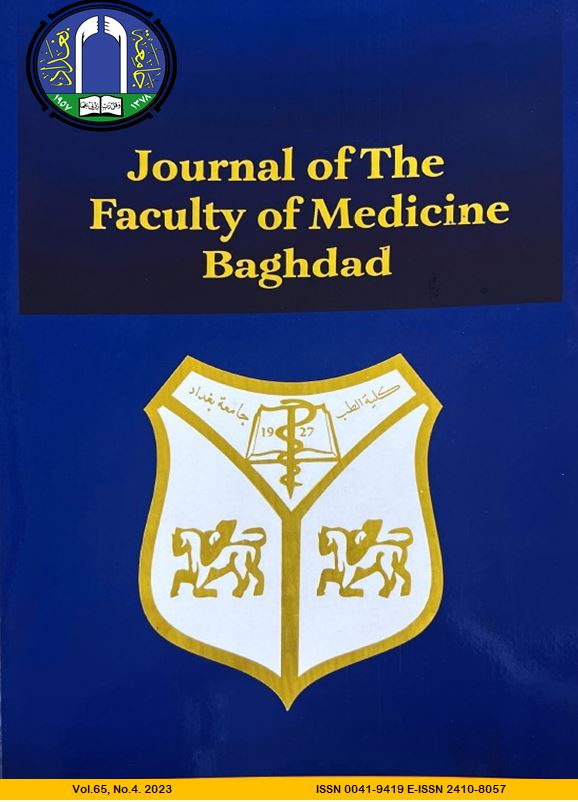Correlation of Serum levels of Chromium, Copper, and Manganese with the Glucose levels in Type 2 Diabetes Mellitus in Iraq
DOI:
https://doi.org/10.32007/jfacmedbagdad.2126Keywords:
BMI, Chromium, Copper, Insulin, Insulin resistance, Manganese, Type 2 diabetes.Abstract
Background: The metabolism of many trace elements, such as chromium, copper, and manganese, was reported to be altered in type 2 diabetes mellitus. This element may have specific roles in the pathogenesis and progress of this disease.
Objectives: To evaluate the serum levels of copper, chromium, and manganese in type 2 diabetic patients in Iraq.
Methods: This case-control study included 100 type 2 diabetic patients, 35-60 years old, with high BMI as cases, and 100 non-diabetic subjects as controls who were healthy volunteers not suffering from type 2 diabetes (staff and students). The data was collected from October 2022 until January 2023. The cases were seen in the Diabetes Consultation Unit at Baghdad Teaching Hospital, Medical City. Serum chromium, copper, and manganese were measured using atomic absorption. ELISA was used to test for insulin. spectrophotometry to measure glucose and HPLC was used to measure whole-blood HbA1c. Insulin resistance was calculated using the semi-empirical formula: HOMA-IR = glucose * insulin / 405 (glucose in mg/dl). To test for the difference between means of numerical data across several parameters, ANOVA tests were utilized. Pearson’s. correlation was used to test the correlation between variables.
Results: Diabetics had higher HbA1c, serum copper, and blood glucose than healthy controls. Compared to controls, diabetics had lower serum chromium and manganese (P value < 0.01). In diabetics, chromium and manganese are highly negatively correlated with insulin resistance. Copper levels increase with increasing insulin resistance. Insulin levels were greater in type 2 diabetics (18.6 ± 4.1 mlU/L) than in the control (6.2 ± 1.3).
Conclusions: Serum copper was high while serum chromium and manganese were low in type 2 diabetics. which indicates that these elements may have a role in the occurrence and development of type 2 diabetes.
Received: May, 2023
Revised: July 2023
Accepted: Oct., 2023
Published: Jan., 2024
Downloads
References
1. Konieczynski P, Gappa M, Wesolowski M, Pinto E, Almeida A. Trace Elements in Medicinal Plants Traditionally Used in the Treatment of Diabetes-Do They Have a Role in the Claimed Therapeutic Effect? Foods. 2022;11(5). https://doi.org/10.3390/foods11050667.
2. Aljabere SI, Jaber BA. Serum Zinc and Copper in Children with Febrile Seizures in Basrah,Iraq. J Fac Med Baghdad. 2019;61(1):1-5. https://doi.org/10.32007/jfacmedbagdad.611250.
3. Al Doori KM. Serum Status of Selenium and Chromium in Patients With Cardiovascular Diseases and Controls in Iraq". JFacMedBaghdad, 2009; 50(4): 428-30, https://doi.org/10.32007/jfacmedbagdad.5041169
4. Ferencikova V, Osina O. Potential of Selected Trace Elements in Patients with Diabetes Mellitus. Acta Medica Martiniana. 2018;18(3):17-23. https://doi.org/10.2478/acm-2018-0013/.
5. Cui Z, Chen H, Lu W, Wang P, Zhou Z, Zhang N, et al. The Association Between Plasma Copper Concentration and Prevalence of Diabetes in Chinese Adults With Hypertension. Front Public Heal. 2022;10(June):1-9. https://doi.org/10.3389/fpubh.2022.888219.
6. Chen H, Cui Z, Lu W, Wang P, Wang J, Zhou Z, et al. Association between serum manganese levels and diabetes in Chinese adults with hypertension. J Clin Hypertens. 2022; 24(7):918-27. https://doi.org/10.1111/jch.14520.
7. Al-Juboori IA, Al-Rawi R, A-Hakeim HK. Estimation of Serum Copper, Manganese, Selenium, and Zinc in Hypothyroidism Patients. IUFS J Biol . 2009;68(2):121-6.
8. Pasupathi P, Farook J, Chinnaswamy P. Oxidant-antioxidant status, highly sensitive C- reactive protein and homocysteine levels in type 2 diabetic patients with and without microalbuminuria, Int J Biol Med Res 2010;1(3):04-40.
9. Cui Z, Zhou H, Liu K, Wu M, Li S, Meng S, et al. Dietary Copper and Selenium Intakes and the Risk of Type 2 Diabetes Mellitus: Findings from the China Health and Nutrition Survey. Nutrients. 2022;14(10).https://doi.org/10.3390/nu14102055.
10. Grădinaru D, Margină D, Ungurianu A, Nițulescu G, Pena C, Ionescu‑Tîrgoviște C, et al. Zinc status, insulin resistance and glycoxidative stress in elderly subjects with type 2 diabetes mellitus. Exp Ther Med. 2021;22(6):1-6. https://doi.org/10.3892/etm.2021.10829.
11. Chen G, Liu P, Pattar GR, Tackett L, Bhonagiri P, Strawbridge AB, et al. "Chromium activates glucose transporter 4 trafficking and enhances insulin-stimulated glucose transport in 3T3-L1 adipocytes via a cholesterol-dependent mechanism." Molecular endocrinology 20.4 (2006): 857-870. https://doi.org/10.1210/me.2005-0255.
12. Viktorínová A, Toserová E, Krizko M, Duracková Z. "Altered metabolism of copper, zinc, and magnesium is associated with increased levels of glycated hemoglobin in patients with diabetes mellitus." Metabolism 58.10 (2009): 1477-1482. https://doi.org/10.1016/j.metabol.2009.04.035.
13. Yuan L, Peng L, Han J, Liu B, Wu Y, Chen J. "Effect of Cu addition on microstructures and tensile properties of high-pressure die-casting Al-5.5 Mg-0.7 Mn alloy." Journal of Materials Science & Technology 35.6 (2019): 1017-1026. https://doi.org/10.1016/j.jmst.2018.11.024.
14. Uriu-Adams JY, and Keen CL. "Copper, oxidative stress, and human health." Molecular aspects of medicine 26.4-5 2005: 268-298. https://doi.org/10.1016/j.mam.2005.07.015.
15. Forte G, Bocca B, Peruzzu A, Tolu F, Asara Y, Farace C, et al. "Blood metalsconcentration in type 1 and type 2 diabetics." Biological trace element research 156 (2013): 79-90. https://doi.org/10.1007/s12011-013-9858-6.
16. Khan AR, and Awan FR. "Metals in the pathogenesis of type 2 diabetes." Journal of Diabetes & Metabolic Disorders 13 (2014): 1-6. https://doi.org/10.1186/2251-6581-13-16
Downloads
Published
Issue
Section
License
Copyright (c) 2023 Ahmed Z. Khamees & Hedef D. Al-Yassin

This work is licensed under a Creative Commons Attribution 4.0 International License.












 Creative Commons Attribution 4.0 International license..
Creative Commons Attribution 4.0 International license..


